
|
Iain Banks's Complicity: A Reader's Guide
Paperback / softback
Main Details
Description
This is part of a new series of guides to contemporary novels. The aim of the series is to give readers accessible and informative introductions to some of the most popular, most acclaimed and most influential novels of recent years - from 'The Remains of the Day' to 'White Teeth'. A team of contemporary fiction scholars from both sides of the Atlantic has been assembled to provide a thorough and readable analysis of each of the novels in question. This is an excellent guide to Iain Banks's bestselling novel. It features a biography of the author, a full-length analysis of the novel, a comparison of the book to the movie, and a great deal more. If you're studying this novel, reading it for your book club, or if you simply want to know more about it, you'll find this guide informative
Author Biography
Cairns Craig, Edinburgh University
Reviews"Study Aids Get Chic Concerned about keeping up at the book club? Stuck for something to say when dinner party talk turns to Zadie Smith? Or no time to read Captain Corelli's Mandolin before the movie comes out? Never fear, cool new study aids are here in the form of Continuum Contemporaries....The Novel Approach, a series of handy readers' guides to contemporary fiction. Launching in September, with further waves in January and May 2002, they're much slicker than the frumpy cheat-aids of yore, including everything from website links to review buzz, and deliberately featuring new novels such as Bridget Jones's Diary, The Shipping News, Trainspotting, and even the Harry Potter books." --Time Out (London) "A brilliant idea--short, perceptive books which tell you what you need to know about some of the most vibrant and challenging writing around today--a bit like having a reading group in your pocket."--Ian Rankin "The series comes as near to squaring various circles - popular / academic, 'good read' / 'classic Lit', novel / film of the book as any I know. And at best it goes a fair way towards reshuffling those categories and redrawing the boundaries. With the first volume, I was relieved. After two or three, I was hooked. The books are invaluable for gathering out-of-the-way or ephemeral comment from TV and radio interviews and the web as well as from literary reviews. Refreshingly upfront and up-to-date... Given the space, there are remarkably balanced film/novel comparisons of the most well-known examples... An important feature is the fully referenced bibliographies, including reviews and copious website addresses - the latter ranging from fanzines and authors' and publishers' own sites to academic discussion lists and online journals. In method as in subject matter, these guides move freely on the interface between print culture and multimedia. Highly finished and pleasantly handleable as books in their own right, they gesture accommodatingly to both words and worlds beyond. Taking the series as a whole, it also confirms two things: that narrative nowadays is generically highly hybrid and increasingly cross-media; and that an understanding of the processes of writing and reading 'contemporary classic' (or at least 'currently famous') fiction cannot be separated - yet must be distinguished - from the processes of making and marketing books and films." -- The Times Higher Education Supplement, May 31, 2002
|